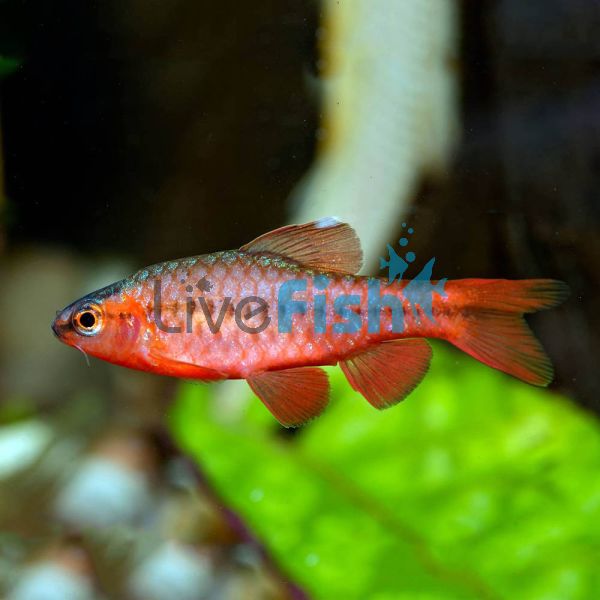Cherry Barb 2cm
Cherry Barb
The cherry barb has got to be one of the most stunning naturally occurring fish in the world. The saturated red colour in males is truly breathtaking when seen in mature fish, even more so when kept in a planted aquarium. These fish have the colours of a tropical tetra, are extremely hardy, and stay small which makes them fantastic beginner fish. Cherry barbs as juveniles can look quite washed out which is why aquarists tend to skim over them in stores but once these fish settle in and mature the true beauty of their colours shine.
Males develop a metallic blood red colour from head to tail whereas females have a more orange tiger-style look with brown barring and stripes. In males especially the red colouration is overlaid with an iridescent jade green hue which gives these a real shimmer in the aquarium as they swim, along with the black highlights towards the face providing the perfect contrast and balance. Breeding cherry barbs are quite straightforward, they are egg scatterers and don't exhibit any parental care. females release their eggs among fine-leafed plants where they are fertilised by the male. The eggs hatch within a few days, and the fry can be fed infusoria or finely crushed flake food. These will also make for a great breeding project for budding fish breeders to try out their experience in egg-scattering fish. Females will be visually different too, they are also larger.
Tank Recommendations for your Cherry Barb
Being a small and relatively easy to care for fish the cherry barb can be kept in smaller aquariums with the minimum being 40 litres. This aquarium size allows for a decent school of these barbs along with other community fish if required. Cherry barbs ideally need to be kept in a group of 5 or more to ensure they feel comfortable. These fish won’t care too much about hardscape or substrate choices however a lot of bright green plants will contrast the red very well.
Suitable Tank Buddies
Cherry Barbs are peaceful fish and generally do well with a variety of tank mates. They can also be mixed with long fin and albino cherry barbs to create a very dynamic mix of fish.
Usually Compatible
Small to medium-sized community fish, other peaceful barbs, tetras, guppies, and bottom dwellers such as corydoras and loaches are good companions.
Sometimes Compatible
Dwarf cichlids and gouramis are sometimes compatible, but care must be taken as they can sometimes be territorial.
Rarely Compatible
Large, aggressive, or predatory species such as Oscars, as well as fin-nippers, should be avoided as they can stress, predate, or harm these small barbs.
Feeding your Cherry Barb
Cherry barbs are a very easy fish to feed. They will take a wide range of pellets, flakes, and frozen foods. Just like any fish though they should be fed a varied diet with a mix of different foods. The ideal diet would be a good quality micro slow-sinking pellet or crushed flake, supplemented with frozen bloodworms and even live foods like baby brine shrimp. Providing them with a portion of natural colour-enhancing food that contains astaxanthin will enhance the colours as well.
| Scientific Name | Puntius titteya |
|---|---|
| Care Level | Easy |
| Common Names | Cherry barb |
| Diet | Omnivore |
| Fish Family | Cyprinidae |
| Lifespan (years) | 5 |
| Max. Length (cm) | 5 |
| Min. Tank Volume (l) | 50 |
| Origin | Asia |
| Reef Safe | Yes |
| Sociability | Peaceful |
| Venomous | No |
| Water Conditions | 23-28° C, pH 6.0-7.0 |




